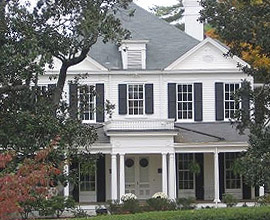
Named in honor of James Mendenhall and founded in 1816, Jamestown, NC was the earliest continuing settlement in the Piedmont region. More recently, archeologists have found evidence of nearby human habitation dating back thousands of years.
A rich and varied history is the foundation for Jamestown today, which prides itself on protecting and enhancing our natural, cultural and historic resources for all to enjoy.
As early as 1701, the Keyauwee Indians were living in a village in this region. They enjoyed the area's mild climate, abundant natural resources, and the fertile hunting grounds along the Deep and Uwharrie Rivers.
Part of a loose confederacy of 20 or more tribes, it is believed that by the 1760s, the Keyauwee had moved south close to the boundary between the two Carolinas where they were likely absorbed by the Catawba tribe.
Additional References:
https://www.sciway.net/hist/indians/keyauwee.html
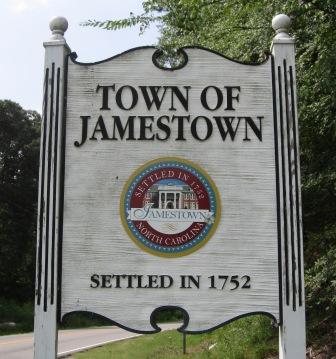
By the late 1700s, European settlers came to Jamestown. Many were Quaker families who moved to the area from Pennsylvania in search of productive farmland. Among the original settlers was James Mendenhall, who established a farmstead near present day Jamestown in 1762. Though Mendenhall moved to Georgia in 1775, his son George remained, and by 1816, he founded the village of Jamestown in honor of his father.
The Mendenhall family, who owned and operated the area's first grist and lumber mills, also owned much of the town's original land. Today, High Point City Lake is situated where the original family farmhouse and land was located.
In 1781, during the Revolutionary War, British General Cornwallis' army camped near the settlement and commandeered provisions from local farms and mills prior to his engagement with Nathaniel Greene's troops at New Garden.

By 1800, Jamestown was a bustling settlement of 150 residents with its own post office, inn and Free Mason's lodge. Around this same time, gold was discovered near Jamestown, and several mines profited until the California gold rush frenzy shut down local efforts.
In 1811, James Mendenhall's son Richard, a local tanner, built the historic Mendenhall Plantation homestead, a highlight of any tour of Jamestown today.
In addition to farming and related industries, Jamestown was home to a gun factory, which manufactured a sturdy and accurate muzzle-loading gun known as the "Jamestown Rifle," the mainstay of Jamestown's industry through the latter half of the nineteenth century and a highly prized collectible among gun enthusiasts today
During the Civil War, Jamestown's Quakers, who opposed war and violence, attempted to remain neutral. However, the Confederacy demanded that those who were able to make shoes, uniforms, or weapons continue to do so or pay heavy taxes. Also, records indicate Confederate President Jefferson Davis and his entourage passed through Jamestown during its hasty retreat to the South after the Civil War ended.
Jamestown was also a known "stop" along the Underground Railroad, which helped fugitive slaves reach freedom in the North. According to local historical records, many Quaker homes in this area had a trap door leading to the basement to help slaves escape. Further, according to records, the Mendenhall and Beard families were instrumental in assisting in emancipation efforts.
Built in 1856, the railroad bisects Jamestown, and still provides a vital link for freight and some passengers between the port cities to the East and interior destinations.
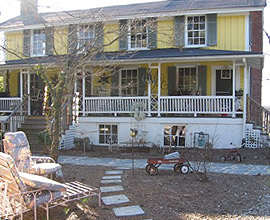
By April 1947, the North Carolina General Assembly granted Jamestown incorporation. Several months after incorporation, Jamestown adopted zoning districts and began construction of a municipal water and sewer system.
T. C. Ragsdale Senior served as the town's first mayor, and Charles P. Turner was the first town manager. More than 60 years later, Jamestown is proud to be managed by only its sixth town manager and its fifth mayor, a testament to the community's stability.
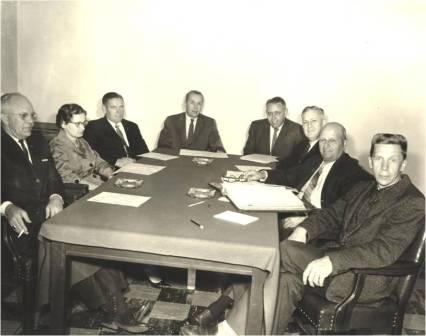
In the 1950's, with a population of approximately 750, the town boasted such improvements as street lighting, water and sewer service, and a fire department.
During the 1960's, Jamestown grew quickly. Several residential neighborhoods sprang from old farmland. An ABC board was formed and a liquor store was constructed, which proved to be a wise investment, enabling the town to pay off debt incurred for water and sewer lines as well as fund the building of Town Hall in 1967 and the Jamestown Park and Golf Course in 1974.
In keeping with Quaker values and as the town prospered, education became a cornerstone of Jamestown.
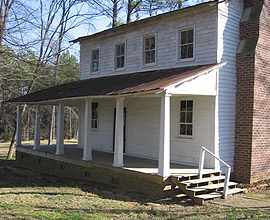
Jamestown was home to several schools, including a Quaker children's school, a seminary for young women, a law school and North Carolina's first medical school, which initially met in the home of Dr. Madison Lindsay.
Built in 1915, the "Old School", a noble neoclassic centerpiece of Main Street, is now the Jamestown Public Library surrounded by a newly-added Common, a vibrant city gathering place.
On the eastern side of Jamestown is Guilford Technical Community College, originally used as a tuberculosis sanatorium until the post-WWII populations required new school facilities.
Today, Jamestown, which continues to be known for its educational prowess, has two elementary schools, one middle school, and one high school.
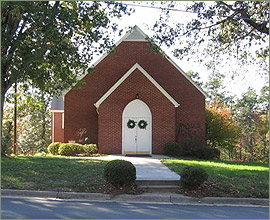
Whether you call Jamestown home, are considering relocating or are visiting, Jamestown has many faithfully restored historic landmarks, perfect for a relaxing and enjoyable tour. To view a map of the historic markers, click here.
With over 3,300 residents living within almost 3 square miles, Jamestown boasts small town charm while being minutes from the bustling Triad region.
Jamestown's commitment to well-planned, quality development strikes a balance between maintaining community character and heritage and attracting a diversity of jobs and businesses.
Our community is proud of our commitment to preserve our cherished natural, cultural and historic resources, and to provide our citizens with quality public services and infrastructure.